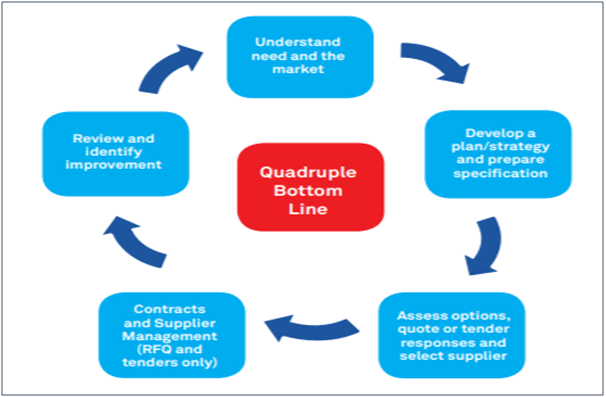Organizations that seek to integrate sustainability into their business practices and strategies are increasing. Social and environmental factors are top priorities to be embedded into procurement and buying functions, to create a sustainable procurement strategy. The procurement strategy will strengthen partnership and facilitate smooth integration.
To obtain best-value prices, procurement professionals have to provide opportunities for potential suppliers to quote, and to adopt a professional strategy towards negotiation.There is an increase focus on evaluating how a company is deemed to have implemented sustainable practices successfully and voluntarily. The impact on ecological, social, and economic environment, is now the inevitable focus.
We work towards a positive impact on people, society and the planet, balancing economic growth and positive social impact with environmental protection and regeneration. These will, in the long run, be able to meet the needs of people without compromising the needs of future generations.
To do so, it requires changes of thoughts and inspiration in lifestyles and consumption, and to adopt and embrace new ways of working. Organisation leaders must be committed and to lead the way forward with the employees, customers and suppliers.
This is both a responsibility and an opportunity to attain the impact and to enable a better everyday life for everyone.It is important to understand the key success factors in implementing a strategy that will generate the desired results.
Table of Contents
Commitment to a Sustainability Policy
Organisation leaders need to ensure sustainable procurement strategy is aligned with the core business strategy. Policies developed based on the needs to future-proof, to ensure supply continuity and, the ability to cope with the demand of emerging markets. The greatest value can arise when a strong business strategy is articulated together with smart supply chain strategy.This can change the focus of supply chain management from simple resource procurement to a set of capabilities that have the potential to generate value for the company. Regardless if it’s business value is short-term and direct, such as cost reduction, or long-term and indirect, such as innovation and customer loyalty.
Adhering to this strategic approach enables alignment to be built across all levels of the organization so that everyone demonstrates the CSR-focused culture.With a clear and renewed understanding of sustainable procurement, an organization is able to save cost, and to apply these non-value added costs to the right place and product. This will bring sustainable growth for the organization with enhanced ethical considerations for corporate procurement goals.

Understanding the Benefits of Sustainability
Achieved positive publicity may attract other financial inventors, boost labor markets and further drive development goals. Compliance with environmental and social legislations leads to minimal risk in a company’s business practices.Sustainability creates an opportunity to renegotiate contracts with suppliers, which in turn, offering further possibilities for a long-term cost savings. It also enables more efficient and effective use of natural resources, reducing the harmful impact of pollution and waste. The harmful impact of hazardous substances on human health and the environment will be reduced. It may also create opportunity for new innovations, to create markets for new products and services.

Setting Goals and Targets
Organisation leaders need to have a comprehensive understanding of supply chain influence to create a sustainable supplier road map. It is essential to engage suppliers’ higher management when developing CSR goals. Some larger scale suppliers may already have internal objectives that can be leveraged and compliment the their clients company initiatives and activities.Larger, globally acclaimed organizations may consider organizing a summit with key suppliers, to outline commitment for joint goals and targets. This will promotes collaborative, trusting relationship to begin a community or ecosystems, that contributes and add value to sustainability. Businesses can gain great deal of time and money from technology. It will help save time, improve efficiency, no printing material and no storage space required for hard copies, when adopting digitalized documentation. This can be an add-on to the goals to attain sustainability.
Setting Standards that Align with Regulations
Sustainable procurement procedures and policies help to structure and put into practice, the sustainable procurement strategy, once aligned with the core business strategy.It is imperative to understand the product and service well in order to derive the right standards. These standards are to be aligned with local regulatory requirements to ensure compliance. They must be reviewed and updated regularly in order to continuously reflect the best practices and account for emerging issues.With the endorsement for organisation’s top leaders, the set standards provide a stabilized and influence which enables values to accumulate.
The full content is only visible to SIPMM members
Already a member? Please Login to continue reading.

